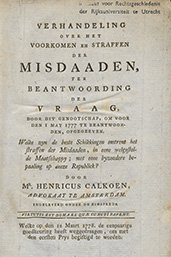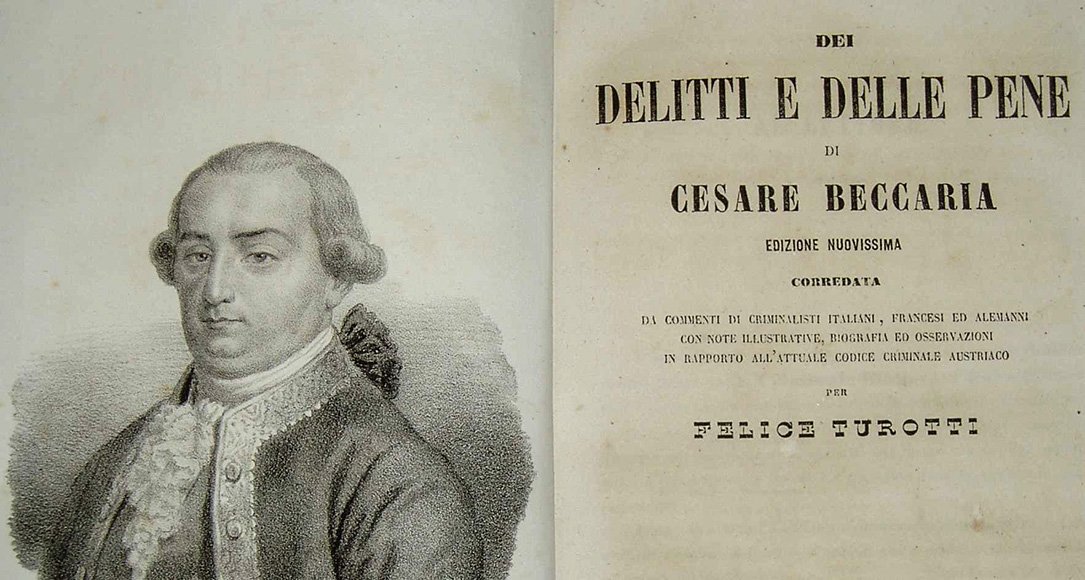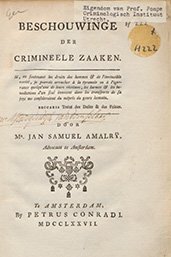Criminal law reform
Criminal law put on the rack
Discussion about criminal law is of all time and of all cultures. The 18th century is no exception to the rule when, especially in Italy and France, heated debates were held about furnishing of proof and punishment. In the Dutch Republic, too, there was talk about reforms. In 1777 and 1780 two works were published on the subject, written by Jan Samuel Amalry and Hendrik Calkoen respectively. Did they want to put criminal law itself on the rack?
Hendrik Calkoen’s career

Hendrik Calkoen was born in Amsterdam on 13 August 1742. He studied law in Leiden between 1761 and 1765 and after taking his doctoral degree was sworn in by the president of the High Court of Holland. According to M.C. van Hall he rarely made an appearance in the courtroom, but is said to have given legal advice on a regular basis. In 1781 Calkoen succeeded his father as clerk of the secretarial office of the Amsterdam city council. He held this job until 1796 when he was expelled by the Amsterdam council on account of suspected sympathies for the former `Orange and Aristocratic administration’. After his dismissal Calkoen again applied himself to the legal profession where his activities went rather unnoticed. He died on 17 June 1818.
The competition

During his adult years Calkoen was actively involved in discussions about current political and other questions. The greater part of his comments were written under the pseudonym of Christianus Batavus. Under his own name Calkoen won the first prize of a competition organised by the ‘Floreant Liberales Artes’ society in 1778. The question was: “what are the best measures to be taken in punishing crimes in an affluent society, in particular this Republic”. Calkoen’s entry was called Verhandeling over het voorkomen en straffen der misdaaden (‘Treatise on the prevention and punishing of crimes’) and published in 1780. This competition and Calkoen’s answer must be considered in the light of a strongly growing interest in the reform of criminal law in the last four decades of the 18th century. France was the forefront and the centre of these discussions. Here the debates about the inhumane and arbitrary character of criminal flared up, in particular after Voltaire’s polemic writings in the 1760s.
Beccaria’s influence

The key work of the movement for the reform of criminal law was written by the young Milan citizen Cesare Beccaria called Dei delitti e delle pene (‘About crimes and punishment’) in 1764. Shortly after it was published in France with a laudatory preface by Voltaire, and it appeared in a Dutch translation in 1768. Beccaria particularly attacked the too severe punishments, the use of the rack and the absence of uniformity in law. Throughout continental Europe there was a system of rigid rules for criminal proof which demanded either a confession or the report of two eyewitnesses in order to pass sentence. Because of these strict requirements the rack was used to extort confessions.

Call for reform
In France from the 1760s onwards a true flood of pamphlets and essays was published which proposed a total reform of criminal law based on Beccaria’s ideas, wanting to replace the old system of furnishing proof by a jury system. Only on the basis of their free inner beliefs the jury would decide about the question of guilt, a reform that was eventually introduced in 1791.
Calkoen’s criticism
Based on his treatise Calkoen is often called the Dutch Beccaria. However, this is at least partly an incorrect title, because Calkoen was in fact very conservative in his ideas and suggested relatively few radical reforms. He does say that his piece was inspired by Beccaria’s work, but he goes on to give a critical evaluation of Beccaria’s writings, rejecting many of his ideas. His major criticism of Beccaria was that he was not a man of the practice and ‘only seems to have seen books’. This remark was not entirely off the mark because Beccaria had no practical experience as legal consultant at all, but focused mainly on a principal debate based on general principles that should be leading in the reform of criminal law. In this respect Jan Samuel Amalry is more deserving of the title of the Dutch Beccaria, because he wholly embraced Beccaria’s ideas and argued the need for a more radical reform of criminal law.
Protection against retaliation
Calkoen starts with arguing that criminal law is a necessary evil and should only be used as a last resort. The prevention of crime will be more successful when the unemployed are offered the chance to earn their daily bread and when the young generation receives a better education. Nevertheless, not all crimes can be prevented and, according to Calkoen, society has the right, based on the social contract, to punish criminals. For Calkoen the criterion for punishableness is not the moral evil of the act, but its harmfulness for society. On utilitarian grounds, he thinks that the aim of punishment is first of all to protect society and not so much to retaliate the crime itself. He also suggests a codification of criminal law in which the crimes are clearly described so that one is sure of what is punishable, what article of law has been broken and what punishment follows. A good criminal code must leave as little as possible to the decision of the judge, in this way preventing arbitrary decisions.
Jury and death penalty
Apart from these `enlightened’ principles, Calkoen had relatively moderate ideas about reforming criminal law. These ideas of Calkoen can be seen in his treatment of several subjects which the ‘enlightened’ lawyers argued particularly in favour of. Beccaria said that the judge should be forbidden to explain the law whereas Calkoen thought that this was a practical impossibility and that the judge should be given some room to interpret the law. It is true that Calkoen is in favour of a more humane penal system, but we should not make the mistake writers such as Beccaria make to have the interests of criminals put before the interests of society. Based on this consideration, Calkoen is in favour of the death penalty and, more striking, also in favour of the rack, although in a more restricted fashion. Calkoen, who attaches great importance to confessions, deems the advantages of this method for society greater than the disadvantages. Also at this point he thinks that Beccaria approaches the subject too much from the defendant’s point of view.
The situation in the Dutch Republic
For the larger part Calkoen is satisfied with the state of affairs concerning criminal procedure in the Republic and especially in his hometown Amsterdam. He thinks that the many and disgraceful abuses complained about by the reformers in France were relatively scarce in the Republic. In his view this was due to the fact that judges in the Republic passed sentence in an objective and careful way. Calkoen was not alone in his opinion, his satisfaction was shared by many. Radical proposals such as the introduction of jury law – in France largely stemming from distrust against the allegedly corrupt judges – are remarkably no topic for discussion in the Republic before the Batavian revolution. Also Calkoen does not mention this subject, although it is talked about in almost all French treatises. Discussions about criminal law in this period in the Republic were of a fairly mild character. However, there is an exception to this rule.
A radical sound: Jan Samuel Amalry

A more critical stand than Calkoen’s can be found in the works of Jan Samuel Amalry. Amalry was born in 1750, presumably in Rotterdam. In 1775 Amalry finished his law study in Leiden and the next year he registered as a lawyer in Amsterdam. He also settled there and was admitted as a member of the Walloon Church. Shortly after he left for Rotterdam, married with Louise Ann Mason and would continue to live in this city. In his short year in Amsterdam, however, the small work Beschouwinge der crimineele zaaken (‘View on criminal matters’) appeared which he wrote at a relatively young age. Amalry died on 25 December 1811 in the countryhouse Polderrust near Hillegersberg.
The Dutch Beccaria?
Amalry is probably the best candidate to be given the title of ‘Dutch Beccaria’. Not because of the great or innovative influence he exerted - only a few copies of his work were printed and it seems to have had little impact - but rather because he shows himself to be a great fan of Beccaria’s ideas. Already on the first page we find a quote by Beccaria which he cites often and with approval. It is a relatively short work, circa 100 pages, and aims to defend the rights of men and to discuss a number of flaws in the chapter on criminal jurisprudence. The book is rather unstructured, is somewhat muddled in its formulations and has no clear beginning or end; it finishes abruptly without summary or conclusion.
Objections to the death penalty
Just as Calkoen, Amalry departs from the social contract to defend the right of society to administer punishment. Contrary to Calkoen, Amalry is more critical of the existing administration of criminal justice and the flaws in criminal law. That is why Amalry argues in favour of radical reforms in the spirit of Beccaria’s work. In chapter four he explains his objections to the death penalty and says that it is improper and unnecessary. Punishment should only deter others from committing crimes and should lead to the reform of the punished person. For the sake of deterrence it is more important to administer a (milder) unescapable punishment than to inflict the most ‘elaborate tortures’. Amalry also concludes that fixed punishments must be set down in the law in order to limit the arbitrary power of the judge.
Standing up for the defendant
Finally in the last three chapters – chapters seven, eight and nine – Amalry makes a number of important suggestions which should change criminal law in favour of the defendant. He thinks that the defendant must be able to use legal aid, which to the end of the 18th century was only limitedly possible in the province of Holland (in the province of Friesland this option was more widespread). He also proposes to make the court sessions public and to increase the possibility for appeal. In this period the criminal law procedure in the case of serious affairs generally took place in secret and the possibility for appeal was severely limited. It was particularly important that someone who had already confessed, even though the confession was coerced by torture, could not appeal due to the common rule confessus not appellat.
Monstrosity and sulphur pit
In the last chapter Amalry argues against the use of the rack in remarkably strong words. He calls the rack an ‘unnatural monstrosity, occasionally used to deprave the innocent and hatched up in hell by a dishonourable tyrant dragged up from his wicked sulphur pit’. In conclusion it can be said that Amalry, to a much greater extent, argued in favour of ‘enlightened’ reform than many of his contemporaries such as Calkoen. Possibly he was not particularly original (he followed Beccaria rather without question) but his enthusiasm makes up for his lack of novel ideas.
Author
Ronnie Bloemberg, June 2015


